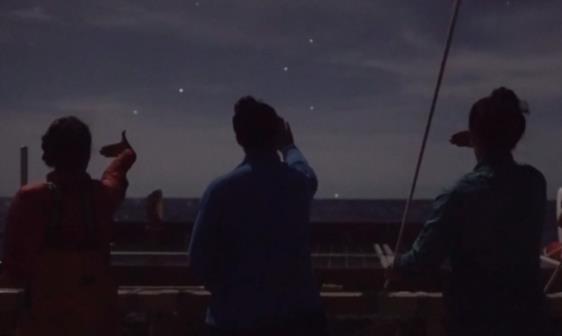
NavList:
A Community Devoted to the Preservation and Practice of Celestial Navigation and Other Methods of Traditional Wayfinding
From: Frank Reed
Date: 2023 May 9, 05:52 -0700
Chris Post, thanks for the National Geographic link. For anyone else interested in reading it, just as Chris says, you can sign up for a free account, and then you have access to a wide collection of articles.
The article makes no significant references to how this all worked, but there's a sign of the improvement in the description of the celestial process that has finally been adopted by the Polynesian Voyaging Society under Nainoa Thompson. The brief video is captioned "crew members use the stars as a compass". And that was and is the most important application of the stars in Polynesian navigations The stars make a very fine compass, and in tropical latitudes, there are some nice simplifications in the process.
And it's likely, despite a lack of hard evidence that Polynesians in the voyaging era used the stars for latitude, too. It would be hard to miss! Modern Polynesian navigators have invented what they believe to be reasonable traditional techniques for estimating latitude by meridian altitudes of stars. It's the sort of technique that would surely have been invented eventually... even if it was not known in some specific century. The video were probably supposed to represent that latitude estimation activity, and in fact, we can get latitude with some accuracy from the video as published. I'm attaching an image. What's the vessel's latitude as seen in the photo? How accurate is your latitude? Hint: you're facing due South, and you're north of the equator. And what is that lonely bright star down low, very close to the horizon??
There's a little map in the article that highlights a key feature of these long voyages from Hawaii to Tahiti. Tahiti by itself would be a hopelessly small target. But they aim for the Tuamotus, which, despite the apparance on a traditional map, constitute a huge target. By aiming left, east of Tahiti, they're sure to bump into an atoll (hopefully not with an actual "bump") and once there, turn hard right and Tahiti is dead ahead.
Modern Polynesian navigation is itself old enough now to be counted as historical. It's been 50 years, Hhalf a century since the PVS was founded. We're only three years from the fiftieth anniversary of the first great voyage of Hokulea, which famously was recorded and publicized in great detail in the pages and maps of National Geographic magazine in 1976. There was no significant internet in 1976, but National Geographic filled a similar role for many in the US back then.
The key point of the article is that the PVS has once again modernized their culture of navigation by bringing in women as head navigators and captains of the vessel. This is a big deal for a traditionally patriarchal activity but hardly surprising since traditional Polynesian society more generally was not patriarchal. The goal of the PVS, like many organizations trying to revitalize indigenous technologies, is not to preserve something prehistoric as if the centuries have not passed, but rather to build something new on the foundations, an imagined modern descendant of those lost prehistoric technologies as well as possible. It's a renewed Polynesian navigation culture brought into the 21st century without abandoning its fundamentals. Stars and clouds and sea birds and other signs of nature? Those are fundamental. Men only? That's no longer fundamental.
Frank Reed







